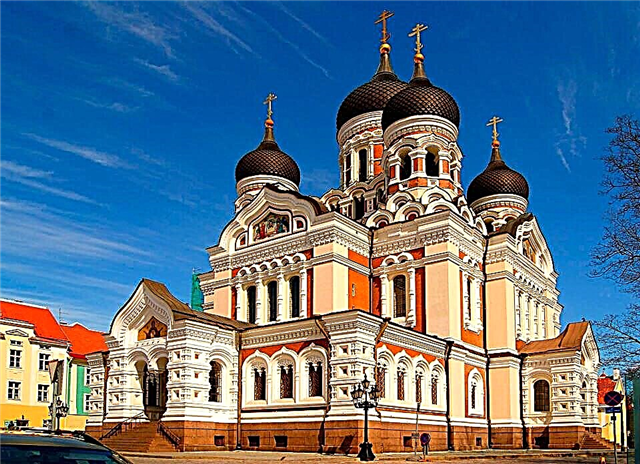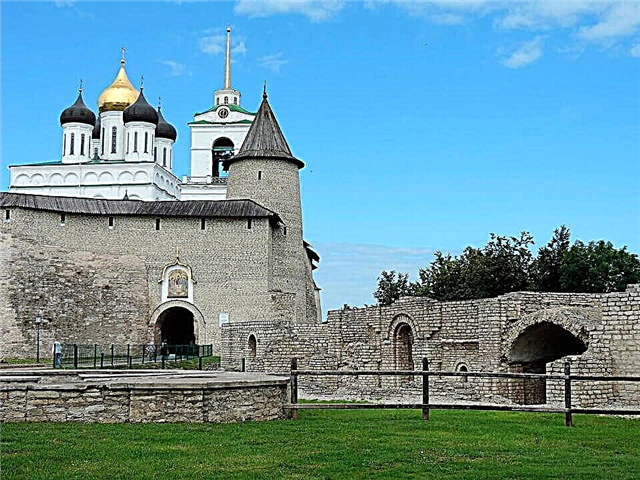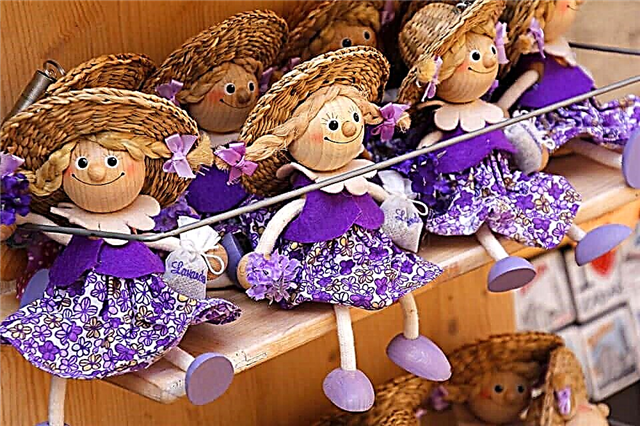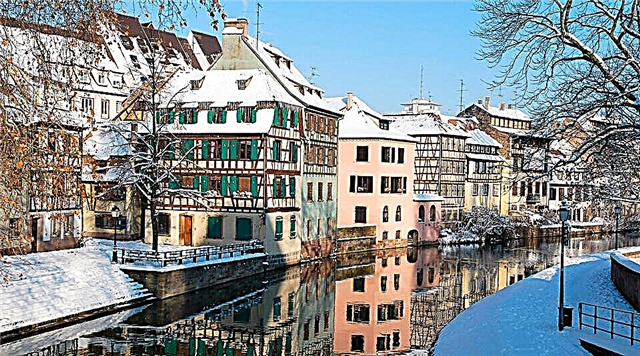Yaroslavl was founded at the intersection of trade routes, so it is not surprising that local princes and merchants built many Christian churches. Monuments of church architecture are one of the main attractions of the ancient Russian city. To see them, tourists come to Yaroslavl from all over Russia.

Assumption Cathedral from a bird's eye view
Why are there many churches in the city?
People began to settle near the confluence of the Volga and Kotorosl from the Neolithic times - V-III millennia BC. One of the oldest Russian cities was founded by Yaroslav the Wise at the beginning of the 11th century, when the prince ruled the Rostov lands. From that time on, Orthodox churches began to be erected in Yaroslavl.
At first, all the churches were wooden. The first stone buildings appeared shortly before the invasion of the Tatar-Mongols, thanks to Prince Konstantin Vsevolodovich. Unlike his father, Vsevolod the Big Nest, Konstantin used not white stone, but brick, and decorated the buildings with white stone decor.

Church of St. Nicholas the Wonderworker in Rubleny Gorod
One of the first stone churches was the city cathedral (1219). Construction proceeded so quickly that soon there were more stone buildings in Yaroslavl than in the capital of the principality - Rostov.
Yaroslavl was located at the crossroads of ancient trade routes. Through it, goods were transported along the Volga and by land. The power of the Yaroslavl princes grew, the city grew richer and acquired a spacious trading settlement and settlements. Merchants made great fortunes, and Yaroslavl artisans were well known not only in different parts of the country. Works by local craftsmen were also eagerly bought in Europe.

Church of Elijah the Prophet
By the 17th century, the Volga city had become one of the richest in Russia. Not only princes, but also wealthy merchants competed with each other and ordered more and more churches from the best architects. Before the 1917 revolution, there were about 100 churches in Yaroslavl.
With the advent of Soviet power, many of them were destroyed, converted for household needs or housing. The situation has changed since the 1990s. Ancient churches began to be restored and returned to believers. New ones appeared to replace the lost ones. Today there are about 40 Orthodox churches and cathedrals in Yaroslavl.

Church of St. Michael the Archangel
Temples of the Chopped and Earthen City
The oldest part of Yaroslavl resembles a spearhead and is located on the Strelka between the Volga and the Kotorosl River. In the old days it was called "Small town". The banks of both rivers on the Strelka are steep and convenient for building defensive fortifications. From the north, the first settlement was protected by a deep Medveditsky ravine.
Along the perimeter, the Rubleny City was quite small - about 1 km. The ancient Kremlin consisted of wooden walls and 12 towers. Inside were the house of the voivode, the chambers where the bishop lived, the princely chambers and Assumption Cathedral.

Church of the Savior on the City
Even in pre-Mongol times, Yaroslavl grew, went beyond the Strelka, and a spacious Earthen City was formed. The construction and settlement of the settlement took place at the expense of numerous visitors - merchants, artisans and peasants. Under Catherine II, a new plan was approved, and the Earthen City began to play the role of the historical center of Yaroslavl.
Since the end of the 17th century, the most ancient part of the city has been decorated with a stone Church of St. Nicholas Rubleny - one of the first Yaroslavl refectory churches. The territory, which was once surrounded by earthen ramparts, has preserved a magnificent Church of Elijah the Prophet, one of two five-domed churches of the 17th century - Church of St. Michael the Archangel, beautiful Church of the Savior on the City and red brick Church of the Presentation of the Lord... In the center, you can also see two posad temples of the 17th century - the church of Nikola Nadein and Church of the Nativity of Christ.

Church of Nikola Nadein
Churches of the old city
Yaroslavl quickly recovered from the consequences of the Time of Troubles, so the 17th century became golden for the Russian city. It developed rapidly as a craft and trade center, and in terms of the turnover of goods was second only to Moscow and Kazan.
The influence of the merchants grew, the merchants grew rich and gained weight in society. In their hands was the trade between East and West. There were about thirty foreign merchant offices in the city. In the second half of the 17th century, 1200 artisans lived in the villages. They were engaged in blacksmithing, fishing, making clay products, and making woolen and linen fabrics.

View of the Tikhvin Church (in the foreground) and the Church of St. Nicholas the Mokroi
In the 17th century alone, three monasteries, 35 stone and 13 wooden churches were built in Yaroslavl. A special Yaroslavl style of architecture was formed. For the decoration of churches, Yaroslavl residents began to use figured bricks and beautiful polychrome tiles. Local craftsmen reached such heights that they were eagerly invited to build churches in other cities of Russia.
Several temples and architectural ensembles have survived to this day in the Old Town. It's white and red churches of the Annunciation parish, a fine example of Elizabethan baroque - the Voznesensko-Sretensky parish in Lovetskaya Sloboda.

Church of the Epiphany
To see the unique wall paintings, tourists who travel to the cities of the "Golden Ring" of Russia come to the old church of St. Nicholas the Wet... The frescoes on its walls were made by the best Yaroslavl isographers of the 17th century.
Tikhvin Church attracts lovers of Russian architecture with glazed multicolor ceramics, and church of the Epiphany - luxurious polychrome tiles and old wall paintings.

General view of the Dmitrovsky parish
Paired temples have become an unusual monument to the victory of Russian weapons on the Kulikovo field Dmitrovsky parish... In the old days, there was a cemetery near these churches, where everyone who died during military campaigns was buried. The main treasure of the church of Dmitry Solunsky is the wall frescoes of the late 17th century.
Several centuries ago, on the outskirts of Yaroslavl, there was a churchyard where city tramps and nameless wanderers were buried. In the second half of the 17th century, a stone Vladimirskaya church... Today it is a rare monument of Russian architecture, because very few three-hipped temples have survived in our country.

Church of the Vladimir Icon of the Mother of God on Bozhedomka
Spiritual life of Zakotoroslya
Residents of Yaroslavl settled not only on the left bank of Kotorosl. Gradually, on the low-lying right bank, separate settlements were formed, and new temples were built. More than others in Zakotorosl is known John the Baptist Church... The most beautiful red-brick building with bright green domes looks like a patterned casket. Inside, you can see over 500 biblical wall paintings.

Church of John the Baptist
Near the mouth of Kotorosl, on the right bank, there is an old Korovnitskaya Sloboda... Tourists and pilgrims come here to look at the ensemble of two temples and a slender 37 m high bell tower, which the townspeople call the "Yaroslavl candle". Church of St. John Chrysostom especially good on the east side. The multicolored ceramic casing on her altar has become one of the hallmarks of the ancient city.
On the territory of a green park in Zakotoroslye rises a white and blue Peter and Paul Church... The temple at the linen factory is effectively reflected in the waters of a large pond and seems to be a real miracle.
Yaroslavl chapels
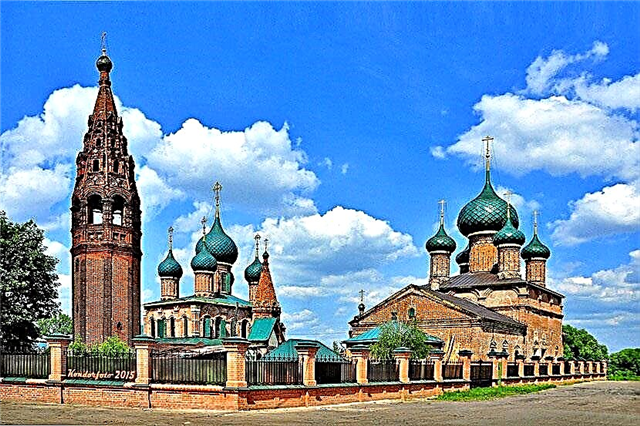
View of the temple complex in Korovnitskaya Sloboda
It has long been customary that chapels were erected in memorable places in Russia. Typically, small temples celebrated special historical events. Chapel of Alexander Nevsky appeared in the city center at the end of the 19th century. It looks like a small hipped bell tower and is dedicated to rescuing members of the royal family during a train wreck.
Kazan chapel on the left bank of Kotorosl - one of the new sights of Yaroslavl. It was erected in 1997 in honor of the feat of the members of the people's militia.



